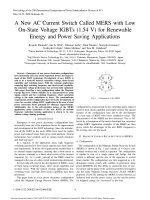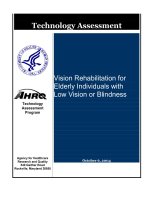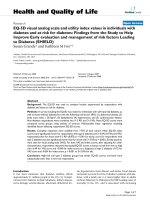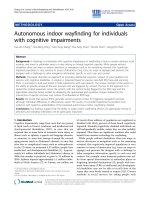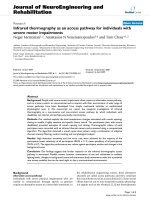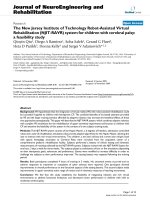Reading rehabilitation for individuals with low vision
Bạn đang xem bản rút gọn của tài liệu. Xem và tải ngay bản đầy đủ của tài liệu tại đây (7.46 MB, 304 trang )
Kamila Růžičková
Reading
Rehabilitation for
Individuals with
Low Vision
Research and Practice in the
Czech Republic
Reading Rehabilitation for Individuals
with Low Vision
Kamila Růžičková
Reading Rehabilitation
for Individuals
with Low Vision
Research and Practice in the Czech Republic
Kamila Růžičková
Dept. Special Education and Speech Therapy
University of Hradec Králové
Hradec Králové, Czech Republic
Advisors
Prof. PhDr. PaedDr. Miloň Potměšil, Ph.D.
Doc. Lea Květoňová, Ph.D.
Doc. PaedDr. Jana Lopúchová, Ph.D.
Translation
Mgr. et Mgr. Vlasta Lišková
Czech Republic National Library cataloguing in Publication Data
617.751 * 316.344.6-056.262 * 617.75-08 * 615.8
376.1-056.262 * 159.262
- Low Vision
- Special Education
- Functional visual capacity
- Vision Rehabilitation
- Reading performance
617 – Orthopaedics. Surgery. Ophthalmology [14]
364-1/-7 – Social Care and Services
ISBN 978-3-319-43652-4
ISBN 978-3-319-43653-1
DOI 10.1007/978-3-319-43653-1
(eBook)
Library of Congress Control Number: 2016948728
© Springer International Publishing Switzerland 2016
This work is subject to copyright. All rights are reserved by the Publisher, whether the whole or part of
the material is concerned, specifically the rights of translation, reprinting, reuse of illustrations, recitation,
broadcasting, reproduction on microfilms or in any other physical way, and transmission or information
storage and retrieval, electronic adaptation, computer software, or by similar or dissimilar methodology
now known or hereafter developed.
The use of general descriptive names, registered names, trademarks, service marks, etc. in this publication
does not imply, even in the absence of a specific statement, that such names are exempt from the relevant
protective laws and regulations and therefore free for general use.
The publisher, the authors and the editors are safe to assume that the advice and information in this book
are believed to be true and accurate at the date of publication. Neither the publisher nor the authors or the
editors give a warranty, express or implied, with respect to the material contained herein or for any errors
or omissions that may have been made.
Printed on acid-free paper
This Springer imprint is published by Springer Nature
The registered company is Springer International Publishing AG
The registered company address is: Gewerbestrasse 11, 6330 Cham, Switzerland
Foreword
The development of vision rehabilitation, including reading skills, is a constant subject of interest to specialists, and the author of this publication has been dealing with
the issue for many years.
The content of the book is the result of a well-prepared concept. Due to the fact that
the book is intended for professionals, the author considers the factor of development
and discusses the dynamics of individual segments of the concept. The book includes
chapters on visual perception and its defects, psychosocial aspects of visual impairment in the context of the age of their bearers and the status of the issue at the national
level. Most importantly, the book contributes knowledge about the development and
innovation of a rehabilitation programme with the use of modern theoretical, assistive
and technical means. The author’s original scientific contribution consists of the creation of an innovative rehabilitation programme for individuals with low vision along
with the research behind the programme. The results of the research provide verification data of the effectiveness of this experimental programme.
The client-oriented approach to individuals with low vision, i.e. rehabilitation
with the aim of developing functional vision and reading skills, has become not
only a support for special education facilities but also an important activity for
workers in social and other services. To understand the basic principles, objectives
and methodology of vision rehabilitation, the author works in a broad interdisciplinary context, thus making the publication useful for professionals outside the field of
special education.
Palacky University in Olomouc, Czech Republic
January 20, 2016
Miloň Potměšil
v
Preface
Care, education and rehabilitation have a long tradition in the lands of Bohemia and
Moravia, parts of the present Czech Republic. Current development has been substantially influenced by it. Significant changes in Czech special education were
made possible by the change of political system in 1989. This date initiated a new
period of development. Twenty-five years of development have shown that the level
of the Czech system of social and rehabilitation services for adults with visual
impairment is in many areas comparable with other developed countries. In a few
selected areas, however, it is necessary to continue to work on development and to
achieve global standards of rehabilitation. One of these areas is rehabilitation of
individuals with low vision.
The need to review the current state of knowledge is suggested and evidenced by
a number of important Czech authors (e.g. Jesenský, Moravcová, Růžičková,
Skalická, Vítková). The author uses in her work numerous foreign professional
works which highlight the need for a comprehensive, multidisciplinary-conceived
rehabilitation intervention focused on the special needs of adults (e.g. Lueck,
Silvestrone, Lang, Rosenthal, Faye et al.).
The publication answers a number of questions concerning functional impact of
vision rehabilitation on the increase of functional visual performance of adults with
low vision. The results of the research confirmed the high importance of the experimental rehabilitation programme in all its components (reading rate, reading accuracy and reading comprehension) as well as in the monitored intervening variables
(visual acuity, age, level of reading experience and activity).
Implemented interventions represented a significant potential for the solution of
one of the most acute areas of rehabilitation objectives: they significantly affected
the quality of life of the research group. Based on the achieved data, the author
proposes areas and means for a modernization of the programme of vision rehabilitation which represent a potential for increase in the quality and effectiveness of the
programme.
vii
viii
Preface
The publication is intended for professionals, especially special teachers or education assistants, social and rehabilitation workers. The author hopes that it will
become a stimulus for professional discussions and an improvement of rehabilitation services for persons with low vision.
Recommendation
The need for further development of special education and rehabilitation of individuals with low vision was stressed as the pivotal conclusion of 2001 international
conference ‘Edukace a rehabilitace zrakově postižených na prahu nového milénia’
(Education and Rehabilitation of Persons with Low Vision at the Threshold of the
New Millennium) in the Czech Republic.
The topic of development of a rehabilitation programme for individuals with low
vision was recommended by the Czech prominent specialist Prof. Ján Jesenský,
CSc. (Charles University in Prague). The interdisciplinary research study was
approved by the Ethics Committee of the University Hospital in Hradec Kralove.
Both the University of Hradec Králové and Rehabilitation Centre for Individuals
with Visual Impairment in the Czech Republic participated in the research.
Hradec Králové, Czech Republic
Kamila Růžičková
Acknowledgements
Acknowledgements for the collaboration go to the colleagues Ján Jesenský and Lea
Květoňová (Charles University in Prague, The Czech Republic), Miloň Potměšil
(Palacky University in Olomouc, The Czech Republic), Jana Lopuchová (Komensky
University in Bratislava, The Slovak Republic) and colleagues from the
Rehabilitation Centre for Individuals with Visual Impairment in the Czech Republic.
Acknowledgements also go to all people with low vision who were participating in
the research. Significant assistance was also provided by the University of Hradec
Králové (The Czech Republic).
ix
Contents
1
2
Visual Impairment and Its Impact on Development .............................
1.1 Basic Terminology and Definitions in Vision Rehabilitation ............
1.1.1 Visual Impairment (CZ: Zrakové Postižení) ..........................
1.1.2 Terminological Definition of the Target Group
for Vision Rehabilitation ........................................................
1.2 Classification of Visual Impairment...................................................
1.3 Frequent Reasons of Reduction or Loss in the Czech Republic ........
1.4 Anatomical and Physiological Aspects of Vision ..............................
1.4.1 Basic Visual Functions and Disorders ...................................
1.4.2 Visual Cognition and Its Disorders ........................................
1.4.3 Visual Attention .....................................................................
1.5 Psychosocial Aspects of Visual Impairment ......................................
1.5.1 Specifics of Cognitive Processes ...........................................
1.5.2 Specifics of Adaptation and Coping.......................................
1.5.3 Social Context of Visual Impairment .....................................
1.5.4 Impact of Visual Impairment on Quality of Life ...................
References ...................................................................................................
Rehabilitation of Individuals with Visual Impairment
in the Czech Republic ...............................................................................
2.1 Development of Czech Rehabilitation Interventions in Brief............
2.2 Theoretical Models of Rehabilitation ................................................
2.3 Rehabilitation Paradigm.....................................................................
2.4 Conditions and Principles of Rehabilitation Process .........................
2.5 The Role of Special Education Approaches.......................................
2.5.1 Model of Educational Approach ............................................
2.5.2 Principles of Special Education of Individuals
with Visual Impairment..........................................................
2.5.3 Educational Methods and Techniques....................................
2.5.4 Process and Forms of Education ............................................
1
2
5
7
7
9
10
11
14
16
17
17
22
25
28
34
37
39
41
42
44
46
48
50
50
51
xi
xii
3
4
5
Contents
2.6 The Role of Age Factor in Education ................................................
2.6.1 Specific Educational Approaches to Older Adults .................
2.7 Rehabilitation Programmes................................................................
2.8 The Role of Assistive Devices and Technology.................................
References ...................................................................................................
52
53
55
57
58
Concept of Vision Rehabilitation in the Czech Republic ......................
3.1 Development of Visual Rehabilitation and Training in Brief ............
3.2 Existing Approaches to Visual Training.............................................
3.3 Terminological Problems ...................................................................
3.4 Current Structure and Perspective of Vision Rehabilitation ..............
3.4.1 Current Situation and Its Problems ........................................
3.5 Innovative Vision Rehabilitation Concept:
Theoretical Postulates, Meanings and Objectives .............................
3.5.1 Target Groups .........................................................................
3.5.2 Comprehensive Concept ........................................................
3.5.3 Basic Factors ..........................................................................
3.5.4 Visual Information Modification............................................
3.5.5 Assistive Devices and Technology ........................................
3.6 Vision Rehabilitation Process ............................................................
3.6.1 Assessment and Individual Rehabilitation Plan.....................
3.6.2 Visual Training Techniques ....................................................
3.6.3 Visual Training Techniques ....................................................
3.6.4 Supportive Techniques ...........................................................
3.7 Brief Notes on the Implementation of Visual Training ......................
References ...................................................................................................
61
63
64
65
67
67
Reading as One of the Objectives of Vision Rehabilitation...................
4.1 Theory of Reading Performance ........................................................
4.1.1 Assessment of Reading Performance
in the Czech Republic ............................................................
4.1.2 Reading Skills Development Strategies .................................
4.2 Teaching Recommendations for Reading Skill Training ...................
References ...................................................................................................
Objectives, Questions and Characteristics
of the Research Group Involved in the Study.........................................
5.1 Objectives, Questions and Tasks of the Research ..............................
5.1.1 Research Objectives ...............................................................
5.1.2 Research Questions and Tasks ...............................................
5.1.3 The Basic Research Question ................................................
5.1.4 Operationalization of the Basic Question
into Partial Research Tasks ....................................................
5.1.5 Additional Questions .............................................................
5.1.6 Research Tasks .......................................................................
72
74
75
77
87
89
98
99
107
109
122
127
129
135
136
137
144
147
151
153
153
154
154
154
155
155
156
Contents
xiii
5.2 Characteristics of Research Groups ................................................... 156
5.2.1
Frequency of Observed Group ............................................ 159
References ................................................................................................... 159
6
7
Research Methodology .............................................................................
6.1 Research Planning..............................................................................
6.1.1
Research Situation ..............................................................
6.1.2
Structure of the Course of Rehabilitation Programme ........
6.1.3
Operationalization of the Programme .................................
6.2 Methods of Obtaining and Recording Data .......................................
6.2.1
Method of Data Comparison...............................................
6.2.2
Method of Processing Anamnestic and Diagnostic Data ....
6.2.3
Method of Interview ...........................................................
6.2.4
Method of Qualitative Observation ....................................
6.2.5
Method of Dialectical Experiment ......................................
6.2.6
Experimental Factors ..........................................................
6.2.7
Method of Experimental Testing.........................................
6.2.8
Method of Experimental Measurements .............................
6.3 Methods of Processing and Displaying Data .....................................
6.3.1
Coding Method ...................................................................
6.3.2
Displaying Data ..................................................................
6.3.3
Data Analysis of Case Study ...............................................
6.4 Methods of Data Analysis ..................................................................
6.4.1
Mathematical and Statistical Methods ................................
6.4.2
Qualitative Methods of Data Analysis ................................
6.4.3
Structure of the Analysis of Qualitatively
Verified Relationships and Intervening Variables ...............
References ...................................................................................................
161
161
163
165
166
170
170
170
171
171
172
173
173
174
177
178
179
179
184
184
185
Results of the Research .............................................................................
7.1 Results of Measurement: Individual Cases ........................................
7.1.1
Interpretation of Measurement Results: Proband A ............
7.1.2
Interpretation of Measurement Results: Proband B ............
7.1.3
Interpretation of Measurement Results: Proband C ............
7.1.4
Interpretation of Measurement Results: Proband D............
7.1.5
Interpretation of Measurement Results: Proband E ............
7.1.6
Interpretation of Measurement Results: Proband F ............
7.1.7
Interpretation of Measurement Results: Proband G............
7.1.8
Interpretation of Measurement Results: Proband H............
7.1.9
Interpretation of Measurement Results: Proband I .............
7.1.10 Interpretation of Measurement Results: Proband J .............
7.1.11 Discussion to Individual Cases ...........................................
189
190
191
192
194
196
198
200
202
203
206
208
209
185
187
xiv
8
Contents
7.2 Summary Results of the Measurements
of Reading Performance ....................................................................
7.2.1 Results in the Category of Reading Rate ...............................
7.2.2 Results in the Category of Reading Accuracy
(Number of Errors) ................................................................
7.2.3 Results in the Category of Reading Comprehension .............
7.3 Summary Results Achieved During the Experimental
Programme .........................................................................................
7.3.1 Summary Results and Discussion on Visual Acuity ..............
7.3.2 Summary Results and Discussion on Age .............................
7.3.3 Summary Results and Discussion on Reading
Experience..............................................................................
7.3.4 Summary Results and Discussion on Activity .......................
References ...................................................................................................
262
263
264
Conclusions ................................................................................................
8.1 Conclusions of Empirical Research ...................................................
8.2 Recommendations for Rehabilitation Theory ....................................
8.3 Recommendations for Rehabilitation Practice...................................
8.4 Summary ............................................................................................
References ...................................................................................................
267
267
271
273
276
277
210
210
226
243
260
261
262
Appendix A: Recommendation of implementation
of the interdisciplinary research by the Ethics Committee
of the University Hospital in Hradec Králové—English translation ......... 279
Appendix B: Czech original ........................................................................... 281
Appendix C: Members of the Ethics Committee ......................................... 283
Index ................................................................................................................. 285
List of Abbreviations
ADL
ACVERP
Activities of daily living
Academy for Certification of Vision Rehabilitation and Education
Professionals
ARMD
Age-related macular degeneration/age-related macular
degeneration of retina
CNS
Central nervous system
CR
Czech Republic
CS
Case study
ČUNS
Česká unie nevidomých a slbozrakých (Czech Union of Low
Vision and Blind)
CVI
Cortical visual impairment
CVR
Comprehensive concept of vision rehabilitation
CZV
Centrum zrakových vad v Praze (Centre of Visual Impairment
in Prague)
EBU
European Blind Union
ERL
Experimental rehabilitation lesson
ERP
Experimental rehabilitation programme
FN HK
Fakultní nemocnice Hradec Králové (University Hospital in Hradec
Králové, CR)
ICF
International Classification of Functioning, Disability
and Health (WHO, 2001)
IRP
Individual rehabilitation plan
OD
Optical device
QOL
Quality of life
ROP
Retinopathy of prematurity
RP
Reading performance
RQ
Reading quotient
RRS Dědina Pobytové rehabilitační a rekvalifikační středisko Dědina
(Dědina Residential Rehabilitation and Requalification Centre)
RS
Recording sheet
xv
xvi
SONS Sjednocená organizace nevidomých a slabozrakých
(Unified Union of Low Vision and Blind)
VA
Visual acuity
VF
Visual field
VI
Visual impairment
List of Abbreviations
About the Author
Kamila Růžičková, Ph.D. is Assistant Professor in the Faculty of Education at the
University of Hradec Králové. She has more than 22 years of experience with education, rehabilitation and counselling for people with visual impairment. She is an
expert teacher and lecturer at the Education Centre for Children with Visual
Impairment in Hradec Králové, an instructor of Orientation and Mobility skills and
a teacher of Braille code. Previously, she worked as a professional at the Rehabilitation
Center for Adults with Visual Impairment for 8 years. She is the author of the educational programme ‘Increasing visual performance in reading’ and a monograph,
Visual Rehabilitation for Persons with Low Vision. Dr. Růžičková works as a member of the Czech Republic Governmental Committee for the special needs of people
with disabilities and the Association of Professional Counsellors for children with
special education needs and their families and teachers of the Czech Republic.
xvii
Chapter 1
Visual Impairment and Its Impact
on Development
‘Sight is the sense which enables vision, i.e. the ability to distinguish light, darkness,
colours, shapes, positions and motions, three-dimensionality and depth of space.
Vision provides at least 75 % of information about the surrounding world
(Edelsberger & Kábele in Ludíková (2003)). Vision is classified among remote
analysers; it allows providing complete information in a minimum time interval
with a minimal effort of the individual. It plays an important role in shaping the
correct ideas, the development of memory, attention, thinking as well as emotional
and volitional area’ (Ludíková, 2003, 179). Vision is also the most effective tool for
obtaining information about the outside world. Most practical activities are in fact
based on the management and control via sight.
Contemporary society has been further increasing the dominance of the communication of information through visual perception. The reason is the advantage of
visual form in terms of a high density of provided information and high level of
graphic information through images (thanks to the use of advanced video technologies). The society often defined as visuocentric has been building increasingly more
barriers for persons with severe visual impairment.
Severe visual impairment affects all social relations, performance, professional
career and lifestyle, but it can also intervene with understanding their existence. All
of these attributes mirror also in the creation of value orientation, which is closely
related to the quality of life.
According to WHO statistics, 285 million people are estimated to be visually
impaired worldwide: 39 million are blind and 246 have low vision. In the context of
the ageing of population, also other facts must be taken into account: Almost 82 %
of persons living with blindness are aged 50 and above. Uncorrected refractive
errors are the cause of moderate and serve visual impairment. Sight loss is closely
related to old age—in the next 20 years, the number of persons aged over 85 years
will approximately double, which suggests that also the number of the elderly with
© Springer International Publishing Switzerland 2016
K. Růžičková, Reading Rehabilitation for Individuals with Low Vision,
DOI 10.1007/978-3-319-43653-1_1
1
2
1
Visual Impairment and Its Impact on Development
visual impairment will increase.1 According to European Blind Union, an average
of 1 in 30 Europeans experience sight loss. There are four times as many partially
sighted persons as blind persons. The average unemployment rate of blind and partially sighted persons of working age is over 75 %. More women are unemployed
than men. Women are more at risk of becoming blind or partially sighted than men.
One in three senior citizens over 65 faces sight loss. 90 % of visually impaired persons is over the age of 65.
These data indicate, among other, the need for the development of social and
rehabilitation arrangements (Krahulcová, 2002). ‘The last research of the
Department of Assessment Medicine of the Institute for Postgraduate Medical
Education in Prague (Katedra posudkového lékařství Institutu pro další vzdělávání
v Praze), based on the data of official statistics, estimated the approximate ratio of
population with low vision in the Czech Republic: approximately 20,000 persons
who are blind and 161,900 persons with low vision’ (Jesenský, 2002, 36).
Care, education and rehabilitation have a long tradition on the lands of Bohemia
and Moravia, parts of the present Czech Republic. Current development has been
substantially influenced by it. Significant changes in the Czech special education
were made possible by the change of political system in 1989. This date initiated a
new period of development. Twenty-five years of it have shown that the level of the
Czech system of social and rehabilitation services for adults with visual impairment
is in many areas comparable with other developed countries. In a few selected areas,
however, it is necessary to point out falling behind global standards.
Severe impairment or loss of vision is a serious interference in the lives of individuals and their existence in community. The starting point for any professional work in
the area of education and rehabilitation is the understanding of the specific dimensions
of quality of life in the target group (Bendová, 2013). Jesenský (2002) marks the following dimensions: effective use of visual skills; overall physical condition; quality of
health care; specific values and social status; inclusion in a specific culture; vocational, financial and social security and conditions of employment; conditions for
personal development and mental capacity; possibilities and conditions of socialization and social inclusion; other individual variables.
1.1
Basic Terminology and Definitions in Vision
Rehabilitation
When new systems, strategies and concepts of special education and rehabilitation
are being developed, it is necessary to deal with a number of terminological problems which special education has been facing up to now. At this particular moment
1
Further statistical data on situation in the world are available in WHO reports; information on
current situation in the Czech Republic is analysed by the study focusing on the issues of the quality of life of persons with visual impairment (available from: ; downloaded 2004-03-20). Cerha (2002) reports that 65 % of the clients of Tyfloservis belong to the age
group over 65 years.
1.1
Basic Terminology and Definitions in Vision Rehabilitation
3
of the development of the discipline, we feel the necessity of an interdisciplinary
cooperation and intertwining the knowledge of very different fields of the science.
With the enormous growth of the level of interdisciplinary cooperation, the need of
new terminological definitions has arisen which should reflect the terminology of
all the participating fields of the science. There are many terminological discrepancies especially in this area, i.e. the area of ‘helping professions’, which also includes
comprehensive rehabilitation. This conceptual inconsistency has been caused by a
speedy and much uncoordinated development of complementary fields as much as
by the use of different paradigmatic models.2 The most likely source of confusion
has been the influence of written papers coming from various countries, using different
sets of terms (Růžičková & Balcarová 2006). Based on this, we would like to clarify
the basic terminology used in this work.
Health is, following the WHO definition, a state of complete physical, mental
and social well-being (WHO, 2001).
Permanent health impairment disturbs the well-being of a person in all the three
dimensions mentioned above (Šťastný 2006). The primary cause of health impairment is a disorder. According to WHO (2001), it is a loss or an abnormality of the
anatomical, mental or physiological structures of function of the organism. A primary disease (i.e. internal situation) and its outer functional manifestation create a
risk of the emergence of secondary changes at physical, mental, eventually social
levels, thus causing a drop in the abilities of the person which can result in decreased
ability (impairment) and limited possibility to share in community life (i.e. social
consequences). The term of impairment (or disability) is understood as the opposite
word to the word ability (CZ—schopnost), which, in the above defined meaning,
denotes an ability to exercise any activity in the way and extent corresponding with
norms. Impairment (CZ—postižení, znevýhodnění) can be understood as a limited
ability or a disability of the person to exercise some activities in a similar way or as
effectively as persons in the majority society.
The degree of disability has been described in professional resources as a level of
functional potential or development of the person, proportional to his/her age.
Functional ability should be diagnosed on the basis of definition which assesses the
specific symptoms of individual target group by taking into account the threshold of
decreased abilities (Fig. 1.1).3 In case of an adult, the result of complex functional
evaluation is compared with the abilities of the adult without impairment with average
abilities. See ‘International Classification of Functioning, Disability and Health’—
ICF (Fig. 1.2).4
2
Types of models: medical, educational, sociological, anthropological, charity model, etc. In any
theoretical discipline, there may exist different general terms narrowly applied by the authors to
various areas of problems or target groups.
3
This model cannot be used as the only/primary testing method. The problem consists in the difficulty to determine the threshold of ability in relation to the dynamics of personal development,
conditions, successful rehabilitation and other specific variables.
4
International Classification of Functioning, Disability and Health (ICF) was agreed by the World
Health Organisation in 2001 (WHO, 2001). Except for medical diagnosis, it also takes into account
the limited activity concerning participation in social life, real social and material conditions, etc.
(Švestková, 2005).
4
1
Visual Impairment and Its Impact on Development
Moderate
Threshold
Severe
________ _____
Reduced abilities
Fig. 1.1 Model of the continuum of seriousness of disability shows the border separating the abilities
comparable to population without disabilities and the limited abilities (Douglas et al., 2012)
ICF Biopsychosocial Model
(Mutual relationships of components)
Health problems
Bodily functions
and structures
Activities
Environmental factors
Material
Social
Legal system
Participation
Personal factors
Age, sex
Personality and motivation
Lifestyle
Fig. 1.2 The biopsychosocial model of aspects of health and their relationships (ICF, 2001)
In case that the real consequences of disorder have an impact on the process of
social interaction, education, employment, social and cultural life (and consequently
also on the very area of meaning of existence and life), we can talk about disability
(CZ—postižení).
The emergence of disability is defined in professional resources from various
perspectives. Jesenský (2000) classifies it, on the basis of anthropological paradigm,
through the assessment of quality of life. On the other hand, Schuntermann (1996)
defines handicap on the basis of the level of inclusion into majority society in all the
key areas of life in which the individual is willing to participate.
The term at risk (CZ—ohrožení) also emerges in professional literature. It is
mainly used in the context of the target group of children at risk of developing a
disability.
The International Classification of Functioning, Disability and Health (ICF)
helps to disclose the reasons and relationships of reduced ability, impairment and
1.1
Basic Terminology and Definitions in Vision Rehabilitation
Disease
Reduced level of organ
/ disorfunction
der
Definition
Example
Ophthal
mological
diagnosis
ARMD
Change in the structure or
function of the eye or visual
pathways
Anatomical
structures
Physiological
functions
Degeneration
of
photoreceptors
Central
scotoma,
distorted
vision
5
Reduced ability
resulting in the
Social
reduced quality
consequences
of life of the
patient
Difficulties in
performing
activities of
daily living
Reduced social
ability or
ability to play
certain roles in
society
Impairing the
ability of face
recognition, etc.
Fear of
rejection by
friends,
reduced
independence
Fig. 1.3 Relationship between disease/disorder, reduced ability, impairment and disability
(Dickinson, 2002, 4)
disability. Many countries use it as an exact tool for the classification of special
needs and for rehabilitation prognosis to create individual rehabilitation plan as well
as to shape social policy. Furthermore, it is also an important source for statistics
and research.
1.1.1
Visual Impairment (CZ: Zrakové Postižení)
We can also find in professional texts the following terms describing visual abilities:
visual impairment (CZ—zrakové postižení), visual disorder (CZ—porucha), disability (CZ—znevýhodnění). Persons are called: person with low vision (CZ—osoba
slabozraká), with total visual impairment (or with blindness = nevidomá) or near-total
visual impairment (with legal blindness = prakticky nevidomá). Relationship between
disease/disorder, reduced ability, impairment and disability shows the terminology of
ICF classification also in official translations to respective languages. The table
(Fig. 1.3) provides the classification including the examples of application.
Consistently with the up-to-date anthropological approach, the term ‘individuals with
handicap’ is being replaced by the term ‘individuals with special needs’ (CZ—‘osoby
se speciálními potřebami’) (Květoňová-Švecová, 2004).
The classification of various types of visual impairment following WHO
(2001) creates categories on the basis of the quality of visual functions which,
after the medical therapy and correction of refractive defect, show values: visual
acuity less than 0.3 (6/18) and/or field of vision around central fixation limited to
less than 10°.
Functional visual performance is a term well suited to the needs of rehabilitation
practice. It is defined as the level of functional use of visual potential in cooperation
6
1
Visual Impairment and Its Impact on Development
with visual ability, taking into account also cognitive, conative and environmental
elements5 (Lueck, 2004).
The term rehabilitation, introduced during nineteenth century, was understood as
restoring someone’s abilities again (LAT—re = again, habilis = able) with the aim of
repairing the damaged function of the organism. However, the meaning of the term
has been stretched in current understanding. According to the WHO, rehabilitation
is ‘a process aimed at enabling them to reach and maintain their optimal physical,
sensory, intellectual, psychological and social functional levels’. Nowadays, the
term ‘rehabilitation’ works with a spectrum of objectives, from minimum to maximum. The optimal objective aims for a return to full physical, mental and social
condition. If not possible, alternative objectives are specified. Its objectives are
specified as the effort to minimize the defect, disability or impairment and to prevent the emergence of secondary negative phenomena and processes. ‘The target
group of rehabilitation are persons with motor, sensual, mental, speech, psychological impairments, persons with impairments based on oncological, metabolic, allergic and other problems and their combinations. In terms of age, it concerns all age
categories’ (Švestková in Votava & Buchberger, 2005, 12).
Rehabilitation of individuals with visual impairment (CZ—rehabilitace osob se
zrakovým postižením) according to European Blindness Union is ‘a modern definition (re)habilitation has a holistic approach far beyond the health sector and
embraces a wide range of issues including education, social counselling vocational
training, transport, accessibility and assistive technology’. Jesenský (2003) defined
rehabilitation as the process of capacitating those with undeveloped, lost visual
functions.
Special education of individuals with visual impairment (CZ—tyflopedie) is
most frequently defined as the area of special education and learning of persons
with low vision (Edelsberger & Kábele, 1984). In Czech practical training, it has
mostly been a part of pre-graduation studies. However, in accordance with the
development of understanding of education as a process of lifelong learning, it is
necessary to perceive this particular area of special education in the wider sense.
Its inherent part is special education consultancy and rehabilitation (KvětoňováŠvecová, 2000). In Czech theory, general adult education (CZ—obecná andragogika) has been rather aimed at the processes of shaping the personality in the
areas of self-education and self-realization, which has led to a tendency to understand education as organized intentional activity. However, this understanding does
not fully respond to the needs of special adult education and the necessity to understand education in its widest meaning and to respect the philosophical, anthropological and learning paradigm of education in relation to all stages of life
(Mühlpachr, 2004).
Vision rehabilitation (CZ—rehabilitace zraku) according to American Foundation
for the Blind includes ‘a wide range of professional services that can restore
5
Visual performance has been more frequently related to being diagnosed during basic activities
and conditions—it is interested in the ability of a specific person in critical situations (Lueck,
2004).
1.2
Classification of Visual Impairment
7
functioning after vision loss’. Jesenský (2007) defined vision rehabilitation as ‘a
system of rehabilitation procedures for persons with low vision’. According to the
modern concept, emphasis is placed on the involvement of the potential of whole
personality as well as social and object environment. Thus, vision rehabilitation can
be defined as education towards the use of a set of knowledge, skills and habits
contributing to the optimal use of visual capacity (Růžičková, 2015).
1.1.2
Terminological Definition of the Target Group for Vision
Rehabilitation
Selection of an exact chain of terms to define the target group of potential vision
rehabilitation users required the solution of a terminological problem as the terminological definition of target group does not exactly match the defined categories of
visual impairment classification according to the WHO. It is not only persons whose
visual ability corresponds with the category ‘low vision’ but also a part of the category ‘near-total visual impairment’. However, regardless of such terminological
discrepancies, the general term ‘low vision’ or ‘persons with low vision’ has been
used throughout this study.
1.2
Classification of Visual Impairment
Visual disorder can be classified from many perspectives. The basic criteria are:
time and reason of emergence; type and degree of partial visual ability; etc. The
assessment and evaluation of the level of visual abilities in special education as well
as vision rehabilitation is based on the ophthalmological classification of WHO
2001 (Fig. 1.4). However, the ophthalmological classification based mainly on the
ability of central visual acuity cannot be sufficient diagnostic material for special
education or rehabilitation practice.6 For these purposes, other classification criteria
are also used, on the basis of which other factors substantial for development, education and rehabilitation are assessed. The aim of these criteria, besides the evaluation of functional visual abilities, skills and experience, is also the assessment of
external conditions and personal competences of the individual. In this context, we
can talk also about the detection of biological, psychological and social influences
(Vágnerová, 1999).
6
The traditional medical model of assessment still prevails in the Czech Republic. However, it
cannot suffice due to the lack of information on the patient. Special education diagnostics or ergodiagnostics is used in Czech situation for instance for the creation of individual rehabilitation
plans. In most cases, however, it is not based on exact methods or test batteries and an interdisciplinary team of experts does not participate in it; thus, the evaluation cannot be considered
comprehensive.
